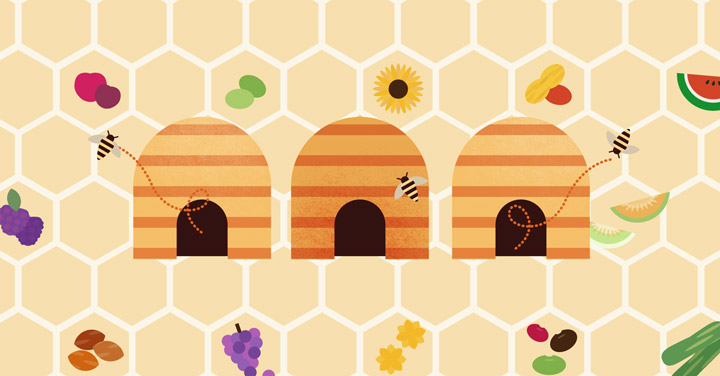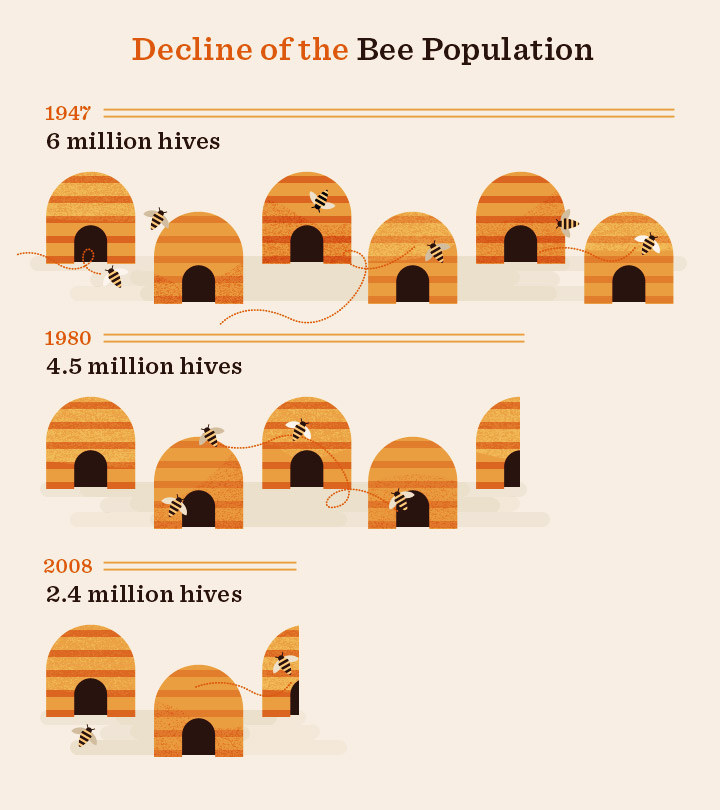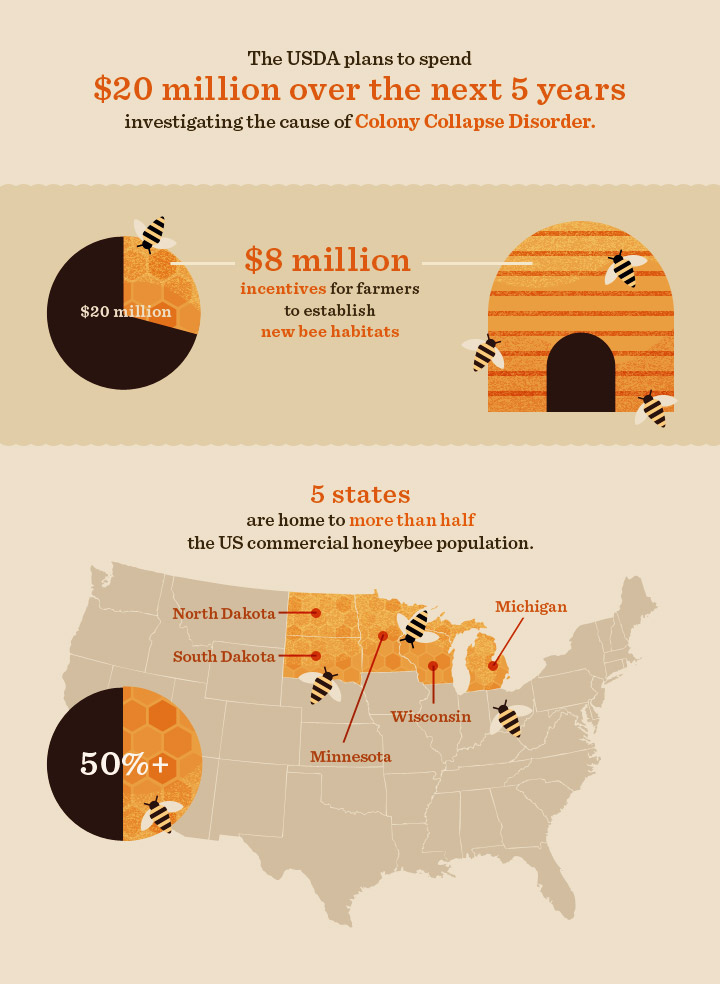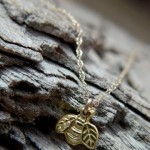How Colony Collapse Disorder affects our food supply
Most people know that, in addition to stinging when angry, bees have a role to play in pollinating flowers. But many don’t realize that pollination work bees do affects the food supply, too. And as bees’ numbers continue to decline at an alarming rate, scientists are starting to ponder what that will do to some of our most essential crops.
For almost 10 years, beekeepers, scientists, and environmentalists have sounded the alarm about disappearing bees. The phenomenon, called Colony Collapse Disorder (CCD), occurs when otherwise healthy bees collectively abandon their hives. No one knows the exact reason CCD happens, or how to stop it. What we do know is that the disappearance of honeybees has serious repercussions for the environment and for the food supply.
What Causes CCD?
In the winter of 2006, beekeepers began reporting high losses of hives, as the worker bee population inexplicably disappeared. Although the queen and young bees remained, without worker bees the hives eventually died. To date, almost one-third of all honeybee colonies in the U.S. have disappeared.
source: http://www.plosone.org/article/info:doi/10.1371/journal.pone.0004071
Why are all the bees vanishing? A variety of factors probably contribute to CCD: the invasive varroa mite; diseases such as Israeli Acute Paralysis virus and the gut parasite Nosema; poisoning from pesticides; and stress. Experts also cite the loss of undeveloped land and with it the decline of good bee forage space. Honeybees require habitat in which to hunt among floral sources, but by some estimates wheat, corn, and soy crops take up over 60 percent of U.S. farmland. That means bees have less and less space for finding adequate nutrition.
Some research points to neonicotinoids (aka neonics, a relatively new variety of insecticides) as the major culprit in CCD. These pesticides are toxic to bees, and may play a significant role in hive deaths. More research is needed to determine exactly how these pesticides and other possible factors work both independently and together to cause CCD.
In the meantime, some countries are taking steps to reduce the risks to honeybees. In 2013, the European Union announced that it would ban the use of neonics for two years in order to determine whether that would help bees reestablish populations.
The U.S., however, has yet to establish regulations in support of honeybees, so a group of beekeepers and environmental consumer groups sued the Environmental Protection Agency (EPA) for lack of bee protection action. Unfortunately, without cooperation from the EPA and farmers, it’s difficult—if not impossible—to implement better bee management practices.
The good news is that the U.S. Department of Agriculture plans to spend $20 million over the next five years investigating the causes of CCD. It’s allotted $8 million in five states to use as farmer incentives. Those spots—Michigan, Minnesota, North Dakota, South Dakota, and Wisconsin—are home to more than half the country’s summer commercial honeybee population; the money is to be used to establish new habitats for bees. President Obama recently announced the creation of a new task force charged with investigating the effects of neonics and other new insecticides on pollinators.
While these efforts are laudable, some farmers and environmentalists worry that they may not be too little, too late. Farmers and grocery chains are already facing a potential loss of crops that bees pollinate each year. This has implications for the U.S. economy, ecosystems, and shoppers in the produce aisles.
Why Bees Matter for the Environment and Our Food Supply
Of course, bees are responsible for honey production, but bees’ influence extends beyond that single product category.
A number of crops rely on honeybees, including apples, almonds, avocados, broccoli, carrots, cucumbers, onions, and pumpkins. In fact, nearly one third of our food supply—or 100-plus crops that provide flavor, diversity, and nutrition—is linked to pollination.
While birds, bats, and insects also help pollinate flowering plants, honeybees are the most reliable and manageable pollinator. Each year, commercial U.S. beekeepers travel from farm to farm around the country with millions of bee hives in tow to pollinate crops such as blueberries, almonds, and other fruits, nuts, and vegetables. Without honeybees pollinating these food items, the U.S. stands to lose up to $15 billion worth of crops.
Humans won’t starve without bees; many communities around the world already survive without these movable bee hives. But we would lose access to a huge number of some of healthy foods, and there would be a steep increase in costs for other crops that farmers continue to grow through alternative pollination techniques.
Almonds are considered a “bellwether” crop for the country’s hives—if almonds suffer from a lack of pollinators, that’s bad news for the rest of the country’s food supply and for the health of local ecosystems. In California, the almond industry relies on 1.4 million colonies of honeybees (nearly 60 percent of all managed honeybee colonies in the U.S.). In stark terms, the loss of bees would equal the loss of U.S. almonds and all the associated jobs and economic benefits.
As pollinators, bees play a major role in maintaining natural plant communities. This contributes to biodiversity (or the presence of a variety of species in an ecosystem), which is vital for the health and proper function of the environment. If bee populations continue decline, that may also signal both dwindling biodiversity and increasingly unstable ecosystems.
Sadly, the destabilization is already happening. U.S. farmers have been forced to reduce the acreage they allot to crops on account of a shortage of honeybees for pollination. The shortage has also driven up costs for renting hives, which also challenges farmers’ ability to grow food. With honeybees dying off around the world, it’s important for everyone—from consumers to government officials—to advocate for identifying the cause of honeybee disappearances and contribute to potential solutions.
Wondering what you can do to help honeybees? Here are a few easy steps to take:
- Grow a garden. Whether you have a giant yard or just a small porch or windowsill on which to plant a few flowers, growing a diversity of plants that are attractive to bees (such as Russian sage and germander) can provide important pollen and nectar sources. Do not use plants that have been treated with insecticides, and keep your garden insecticide- and pesticide- free.
- Let weeds be. Instead of eradicating all the weeds from your lawn, recognize that they’re more than an eyesore. Dandelions and clover, in particular, are two of bees’ favorite foods. So let weeds grow free (and be sure not to spray them with pesticides).
- Ditch the chemicals. Make your yard, garden, and home a commercial pesticide-, herbicide-, and fertilizer- free zone.
- Support pesticide-free food. Purchase pesticide-free produce at the grocery store and farmers’ markets so that you’re supporting crops that are grown in a way that is helpful, and not harmful, to bees.
- Speak up. Sign petitions to ban the use of neonics and other harmful pesticides, and write to your representatives to express your support for finding a solution to CCD.
- Become a beekeeper. Want to take your bee advocacy a step further? Learn how to keep a beehive on your own property. Small hives add diversity to local bee pollinations. Bonus: If you also keep a garden, your bees pollinat it for you!
If this article on the importance of bee’s has you all abuzz, consider adding this honeycomb wine rack to your home. — http://www.custommade.com/honeycomb-wine-rack/by/ironwood-furniture/









